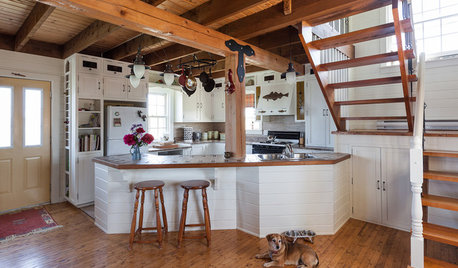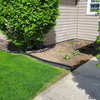Egregious wiggles :-)
woodyoak zone 5 southern Ont., Canada
12 years ago
Related Stories

KITCHEN DESIGNOpen vs. Closed Kitchens — Which Style Works Best for You?
Get the kitchen layout that's right for you with this advice from 3 experts
Full StoryWe were at a local garden/park this afternoon and the first thing that we saw was a path that set off my wiggle aversion! The path split off from the main entrance path; you can see that scale makes a difference - both paths are wiggly but the main path (8' wide) looks better than the side path (4' wide). It's probably just plain impossible to make the broader path so wiggly as the width would force the wiggles to be spread out over a longer length. The paths:
{{gwi:25331}}
The wiggly path particularly struck me as ridiculous as it led to this:
{{gwi:25332}}
A closer view of the rose garden layout:
{{gwi:25333}}
I think a nice smooth curved path would have satisfied both the apparent requirement for curves and not set up such a jarring contrast at the destination. This might not be too clear, but I mean something like this:
{{gwi:25334}}
(I would also have smoothed out the wider path too but it is more tolerable than the small path...)
I really don't understand why it seems de regueur these days to make all paths wiggly in all contexts! Can someone explain that to me?





inkognito
woodyoak zone 5 southern Ont., CanadaOriginal Author
Related Professionals
West Milford Landscape Architects & Landscape Designers · Hyattsville Landscape Architects & Landscape Designers · Lakewood Landscape Architects & Landscape Designers · Kahului Landscape Contractors · Louisville Landscape Contractors · Milford Landscape Contractors · Peoria Landscape Contractors · Seymour Landscape Contractors · South Farmingdale Landscape Contractors · Westchester Landscape Contractors · Bensenville Landscape Contractors · Solana Beach Decks, Patios & Outdoor Enclosures · Los Alamitos Decks, Patios & Outdoor Enclosures · Monroe Decks, Patios & Outdoor Enclosures · Cooper City Swimming Pool Builderswhaas_5a
tanowicki
woodyoak zone 5 southern Ont., CanadaOriginal Author
whaas_5a
pippimac
woodyoak zone 5 southern Ont., CanadaOriginal Author
tanowicki
adriennemb2
inkognito
woodyoak zone 5 southern Ont., CanadaOriginal Author
Yardvaark
eastautumn
karinl
drtygrl
Yardvaark
inkognito
woodyoak zone 5 southern Ont., CanadaOriginal Author
inkognito
adriennemb2
woodyoak zone 5 southern Ont., CanadaOriginal Author
inkognito
woodyoak zone 5 southern Ont., CanadaOriginal Author
Yardvaark
whitecap2
woodyoak zone 5 southern Ont., CanadaOriginal Author
whitecap2
Yardvaark